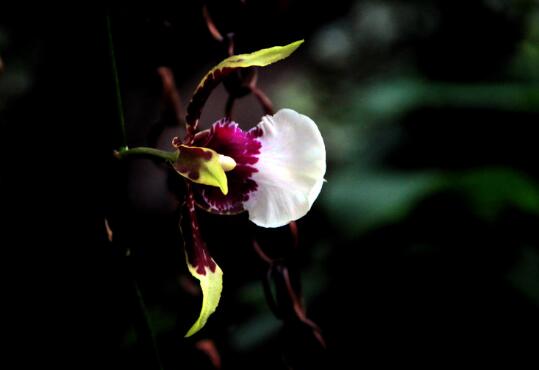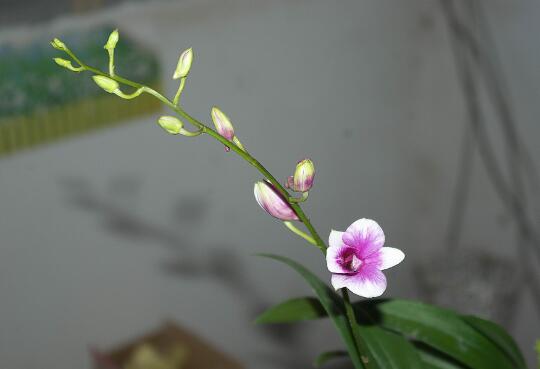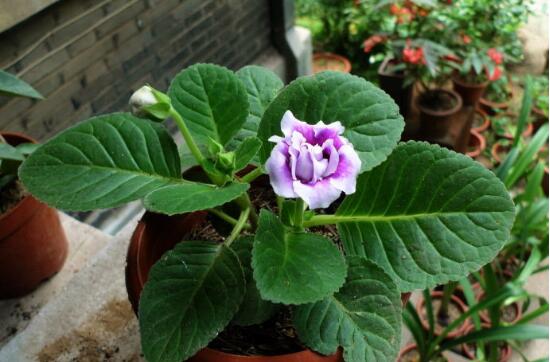How to plant Dendrobium orchid? planting method of potted Dendrobium orchid / temperature control
Among the propagation methods of Dendrobium, it is mainly divided into three methods: sowing propagation, cutting propagation and split propagation, in which sowing reproduction is a more commonly used one, and the survival rate is also very high, but if you want to plant successfully, there are also a lot of things to pay attention to. About how to grow Dendrobium? What is the planting method of potted Dendrobium? Next, the editor will take you to learn about it.
First, how to plant Dendrobium carefully

When it comes to how to grow Dendrobium, there are many methods that we need to pay attention to, such as the selection and disinfection of substrates, the acceleration of seeds, and so on. Of course, the most important thing is to operate carefully. After all, this breeding method has been tested by countless people, and the survival rate is still quite high. As for the specific planting techniques are introduced below, let's take a look.
2. the planting method of potted Dendrobium.
1. Matrix selection
Before we plant Dendrobium, we first need to choose the substrate, which is a good foundation, so it is very important. Generally, it is best to choose well-drained and breathable broken fern roots, water moss, charcoal chips, shredded tiles, perlite, etc., preferably with broken fern roots and water moss, so that the plant will grow better.
two。 Matrix disinfection
After we have selected the substrate, it is best not to plant it immediately. We should first disinfect the substrate so as not to infect the plant with diseases and insect pests. During disinfection, we can break it up and spread it in the sun. We can also put it in an iron pan and stir-fry it, so that even if there are diseases and insect pests, they will be killed because of the high temperature.
3. Seed initiation
Before we plant Dendrobium, we also need to urge the seeds of Dendrobium. We can soak the seeds of Dendrobium in warm water for 1-2 days, and then take them out and sow them when they begin to absorb water and swell. This can not only improve the germination rate of seeds, but also make seeds germinate faster.
4. Planting method
When we plant Dendrobium orchid, we should first apply an appropriate amount of basic fertilizer to the basin soil, then sow the seeds evenly on the soil surface, and after sowing, we can water them after covering the soil with 2cm. When watering, it is best to choose the soaking method, put the flowerpot into the water for 1/2, and let the water soak up slowly, because the seed volume of Dendrobium is small. It's easy to wash it away if you water it directly.
5. Temperature management
After we have successfully planted Dendrobium in accordance with the above methods, we need to maintain it on a daily basis. This plant has very strict requirements for ambient temperature during its growth, so we should pay attention to this. Its suitable growth temperature is between 18: 30 ℃, the most suitable growth period is 16: 21 ℃, the dormant period is 16: 18 ℃, the night temperature is 10: 13 ℃, and the temperature difference is 10: 15 ℃. The daytime temperature more than 30 ℃ has little effect on the growth of Dendrobium, and the winter temperature is not lower than 10 ℃. Seedlings are susceptible to freezing below 10 ℃.
Culture method of Dendrobium how to plant Dendrobium in pot
Dendrobium orchid, also known as orchid, is a perennial herbaceous flower of Orchidaceae. Stems tufted, erect, many-jointed. Simple leaves alternate. Racemes, flowers large, pendulous. Calyx, petals are white, apex light red. Blossom in the deciduous period. Let's take a look at the culture method of Dendrobium.
Culture methods of Dendrobium
Dendrobium is native to tropical Asia and Pacific islands. In the natural state, it is often attached to tree trunks or rocks in the forest. Sex likes warmth and moisture, is not cold-resistant, likes semi-yin, and is afraid of strong light.
Most potted plants are cultivated without soil. The substrate is often cultivated in culture soil made of coarse peat, pine bark, broken brick residue, coarse yellow sand, perlite and charcoal blocks. The root should be well ventilated and properly moisturized.
First, light: the primary environment of Dendrobium candidum is generally in the shade and shade. The planting environment needs moderate shading.
Temperature: Dendrobium candidum stopped growing below 5 ℃ and began to dormancy. When the temperature is too low, attention should be paid to frost injury, and it is best to keep it above 0 ℃. If the temperature is too high, the growth will stop at about 35 ℃, and the most suitable growth temperature is about 25 ℃ ~ 30 ℃.
Third, the matrix: the matrix with good air permeability and good filtration should be used as planting material for Dendrobium candidum. It is generally recommended to use the mixed material of blue stone, granular peat and bark. However, due to large-scale production, the cost is relatively high, a single bark can also be used as the substrate.
Humidity: equipped with a hygrometer, it is best to keep the humidity above 60%. In cloudy and rainy weather, when the humidity is above 90%, ventilation should be strengthened to prevent the occurrence of bacteria.
Fifth, the way of replenishing water and water quality: watering should be sprayed frequently and less drenched. It is generally necessary to wait for the matrix to dry before being drenched.
Sixth, ventilation: Langui ventilation: air circulation is very important for Dendrobium candidum, but also can reduce the occurrence of diseases. Air circulation is also important for the roots in the substrate, so we recommend using granular materials, and watering must be thoroughly watered to bring fresh air into the substrate.
7. Fertilization methods: compound fertilizers with trace elements are used. Apply thin fertilizer frequently, do not use heavy fertilizer, otherwise it will cause fertilizer damage. Slow-release fertilizer can also be used as base fertilizer when sprouting in spring every year.
Dendrobium is not only used as an ornamental, but also a good traditional Chinese medicine to protect the voice and moisturize the throat. Among medicinal Dendrobium, Dendrobium (also known as Dendrobium candidum) produced in Huoshan County, Anhui Province is particularly precious. However, because of the special growth environment and very little yield, Dendrobium should be selected to check its color, look at its shape, smell its taste and chew its gum. The color of iron is the top grade; the shape is rolled up tightly, and there are many circles in the roll; Dendrobium has a heavy fragrance, and most of the chewing gum is the best. Among them, fragrance is the most important criterion for the evaluation of Dendrobium. In addition, the unit weight of Dendrobium can also see the quality of Dendrobium. The heavier the unit weight of Dendrobium is, the better the quality is. However, due to the limited output and high price of Dendrobium candidum, there are a large number of Dendrobium candidum pretending to be aquatic plants, especially in pharmacies. Authentic Dendrobium candidum only a few brands, such as Fulinmen Dendrobium candidum, Tongrentang (the price is slightly higher, about 1.5 times of the former) and other large brands can buy real Dendrobium candidum.
How to plant Dendrobium in pots
Reproduction method
Ramet, cuttage and tissue culture are commonly used.
① ramet propagation was carried out in spring combined with changing pots. The mother plant with dense growth will be held out from the basin, the roots and leaves will be less hurt, the orchid seedlings will be gently broken, and 3-4 plants will be planted in 15cm pots, which is beneficial to shaping and flowering.
② cuttage propagation selects false bulbs that grow and enrich without flowering, cut them from the rhizosphere, cut them into every 2-3 segments, insert them directly into peat moss or wrap the base of cuttings with water moss, keep them moist, take root at room temperature at 18-22 ℃ and take root at 30-40 days after cutting. Potted plants with roots 3 to 5 cm long.
Stem tip and leaf tip were often used as explants in ③ tissue culture, and the differentiation rate could reach about 1:10 on MS medium supplemented with 0.5mg / L 2mae 4murine and 0.5mg / L 6-benzylaminoadenine. The differentiated buds were transferred to contain activated carbon. The MS medium of coconut milk (supplemented with 0.1mg / L of 2 ~ (mae) 4FLY D and 0.1mg / L 6-benzylaminoadenine) could grow normally and form rootless seedlings. When the seedlings were transferred into MS medium containing indolebutyric acid 0.2 mg / L, rooting could be induced and complete plantlets with roots, stems and leaves could be formed.
Artificial planting
The artificial planting of Dendrobium candidum has made a breakthrough. At present, artificial planting is mainly distributed in Pu'er, Dehong and Tiantai of Zhejiang Province in China. It is the first to explore and study artificial tissue culture seedlings, natural growth and semi-natural cultivation techniques of Dendrobium candidum with South China Institute of Botany, Chinese Academy of Sciences. And with Kesai Shenlong Biotechnology Development Beijing Co., Ltd. to establish a cooperative research doctor workstation to explore artificial tissue culture seedling technology and Dendrobium candidum intensive cultivation technology as the representative.
Pest control
Often have black spot disease, virus disease harm, can use 10% antibacterial agent 401 acetic acid solution 1000 times liquid spray. Insect pests are harmful to shell insects and are sprayed with 2000 times of omethoate EC.
The pathogen of Dendrobium leaf spot only harms the leaves of Dendrobium, and the symptoms of Dendrobium cultivated in simple greenhouse appear in late August every year. In the early stage of infection, there were water-immersed spots on the diseased leaves, which slowly expanded into inconspicuous macula, round to oval in shape, with a diameter of 0.8-3.2 cm. The conidiophores grew from the stomata on the dorsal leaves of the mature spots, and gray-black conidium clusters could also be seen in the lower epidermis of the diseased leaves (especially the leaf tips) where the lesions were not obvious. After the spots healed each other, the leaves were yellowed and deciduous. The fallen leaves in the infected orchid garden generally occurred in November, and the leaves in the seriously affected areas had fallen off before March or April of the following year.
Dendrobium Flower language
Dendrobium has rich flower words: "welcome, blessing, purity, auspiciousness, happiness". In addition to the above flower words, it not only symbolizes the father's fortitude, kindness and dignity, but also expresses the children's respect for their father.
The above is the cultivation method of Dendrobium introduced to you by Xiaobian. I hope it can help you. For more information about Dendrobium, please stay tuned.
How to grow Dendrobium in potted plants
Dendrobium belongs to the genus Dendrobium of Orchidaceae. It is one of the earliest orchid plants recorded in Chinese ancient documents. Dendrobium orchid has beautiful flower shape, beautiful flower appearance, colorful, wide variety and long florescence, which is deeply loved and concerned by people all over the world. Next, let's take a look at how to raise Dendrobium. I hope it can be helpful to the flower friends.
1. Brief introduction of Dendrobium
Dendrobium is a kind of orchid plant, which mainly grows in tropical Asia, subtropics, Australia, Pacific islands and other areas, and is very common in southwest China, South China, Taiwan and other regions. Its varieties are very many, the main varieties are Dendrobium nobile, Dendrobium candidum, Dendrobium candidum and so on. According to the development of flower industry, it is also called a very good ornamental plant, and it also has good medicinal value, and it has the curative effect of expelling deficiency heat, tonifying essence and strengthening yin and so on. In our life, there are also many people raising Dendrobium, which are generally cultivated in potted plants. The nature of Dendrobium is very strong, and the flowers give people a kind of peaceful and amiable temperament, which is called the flower of father.
2. How to raise Dendrobium
1. Shading
Dendrobium is often attached to tree trunks or rocks in the tropical rain forest in its place of origin, so it likes the semi-shaded environment. During the peak growth period of spring and summer, shading should be carried out, which can shade 60% of the light, 70% of the light, but more sunlight is needed during the winter dormancy period. Generally, it can block 20% of the light, 30% of the color, or no shade.
2. Heat preservation
Dendrobium likes high temperature and humidity. The overwintering temperature of deciduous species can be as low as 10 ℃ or lower at night, while that of evergreen species should not be lower than 15 ℃. At the same time, attention should be paid to maintaining a large temperature difference between day and night (10 ℃). Too small temperature difference will seriously affect the growth and flowering of Dendrobium.
3. Proper watering
Dendrobium not only likes to have enough water, but also avoid being too wet, which will cause rotten roots and poor growth, or even death. Fallen leaves can be properly dried and watered less in winter, but potted materials should not be too dry and air humidity should not be too low. Evergreen species still need to maintain sufficient moisture as long as the greenhouse temperature is high in winter.
4. Spray frequently
In the sunny, dry and hot growing season, water should often be sprayed around the pot plants to improve air humidity. The humidity in the rainy season is relatively high, so you can stop spraying and pay attention to not accumulating water in the basin.
5. Rational fertilization
Dendrobium likes to apply thin fertilizer frequently, and mature cake fertilizer and water can be applied every 10 days during the growth period, or 0.1% all-element compound fertilizer can be applied outside the root. When deciduous species are dormant and evergreen species are forced to dormancy due to low temperature, fertilizer should be stopped.
Third, how to plant Dendrobium in pot
1. Methods of reproduction
Ramet, cuttage and tissue culture are commonly used.
The main results are as follows: 1. Ramet propagation is combined with changing pots in spring. The mother plant with dense growth will be pulled out of the pot, the roots and leaves will be less hurt, the orchid seedling will be gently broken, and 4 plants will be planted in a 15cm pot, which is beneficial to shaping and flowering.
2. Cuttage propagation chooses false bulbs that grow and enrich without flowering, cut them from the rhizosphere, cut them into 3 segments every 2, insert them directly into peat moss or wrap the base of cuttings with water moss, keep them moist, rooting at room temperature at 18 ℃ and 40 days after cutting. Waiting for the root to grow 3MUR 5cm potted plant.
3. Stem tip and leaf tip were often used as explants in tissue culture, and the differentiation rate could reach about 1:10 on MS medium supplemented with 2mae 4murD0.15murine 0.5mg / L and 6-benzylaminoadenine 0.5mg / L. The differentiated buds were transferred to contain activated carbon. When coconut milk was cultured in MS medium (0.1mg / L of 2meme4murine D and 0.1mg / L 6-benzylaminoadenine), rootless seedlings could be formed. When the seedlings were transferred into MS medium containing indolebutyric acid 0.2ml / L, roots could be induced and complete plantlets with roots, stems and leaves could be formed.
At present, the common ornamental cultivation are Dendrobium candidum, Dendrobium candidum, Dendrobium butterfly, Dendrobium nobile, Dendrobium nobile, Dendrobium candidum, Dendrobium candidum, Dendrobium candidum and so on. Dendrobium is an important variety of cut flowers and potted plants because of its beautiful flower shape and beautiful appearance.
The above is the relevant introduction of this article, I believe you have a simple understanding of this after reading it, if necessary, you can continue to pay attention to the No. 1 home network to learn more information.
- Prev

How to propagate Dendrobium? propagation method / sowing / cutting / ramet of Dendrobium
Dendrobium is one of the orchids, which is highly ornamental and is cultivated by many people in various parts of our country. However, with the increase of cultivation, people are more concerned about its reproduction. How to reproduce Dendrobium? What are the breeding methods of Dendrobium? Next, the editor will take you to learn about it.
- Next

How to propagate paulownia flower? the propagation method / bulb cutting of paulownia flower is the most practical.
The efficacy of the big paulownia flower is very good. It not only blossoms beautifully, but also absorbs dust and makes the indoor air more fresh. Such plants are naturally raised at home by many people, but if they are bought and raised, it is better to plant them themselves, and this requires us to master the breeding methods of paulownia flowers. So how do the big paulownia flowers reproduce?
Related
- Fuxing push coffee new agricultural production and marketing class: lack of small-scale processing plants
- Jujube rice field leisure farm deep ploughing Yilan for five years to create a space for organic food and play
- Nongyu Farm-A trial of organic papaya for brave women with advanced technology
- Four points for attention in the prevention and control of diseases and insect pests of edible fungi
- How to add nutrient solution to Edible Fungi
- Is there any good way to control edible fungus mites?
- Open Inoculation Technology of Edible Fungi
- Is there any clever way to use fertilizer for edible fungus in winter?
- What agents are used to kill the pathogens of edible fungi in the mushroom shed?
- Rapid drying of Edible Fungi

